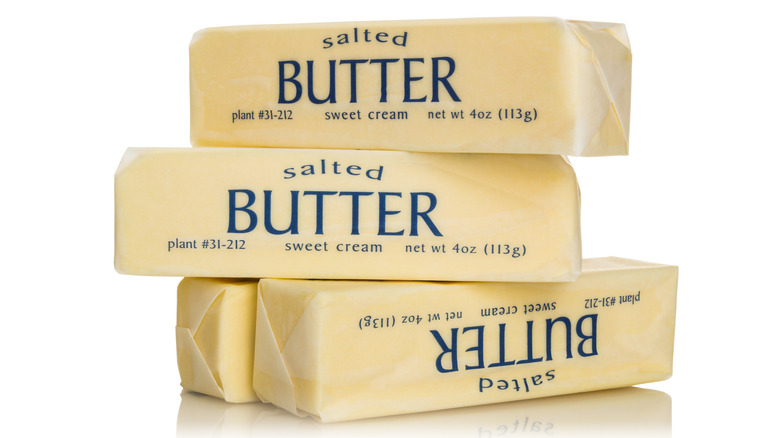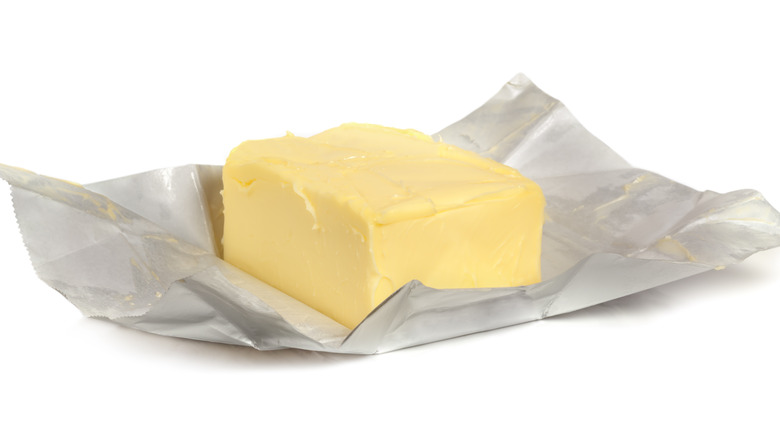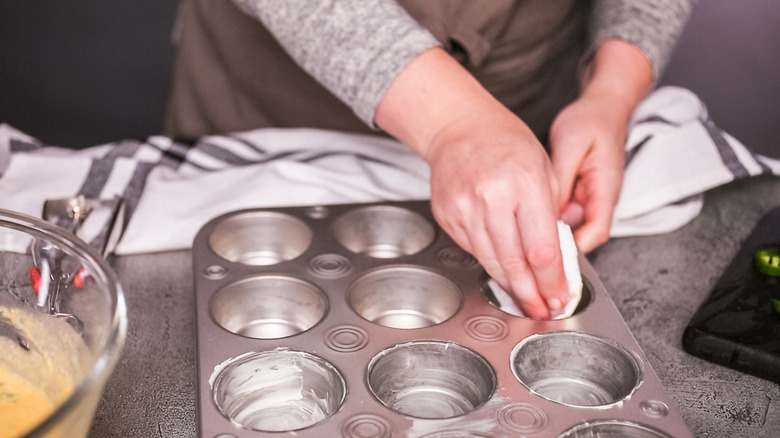You Can Use Butter Papers For One Clever Baking Trick
Bakers use butter by the pound. Some, like Ree Drummond, use a staggering amount of butter. In fact, in a Pioneer Woman blog post, the celebrity chef admitted that she once went through 121 pounds of butter (484 sticks) in just 15 days. Now that's a lot of butter.
Each of those sticks, as you may know, comes wrapped in paper, and for good reason. According to America's Test Kitchen, "If not properly protected, butter quickly absorbs odors from its surroundings — usually whatever else is in the fridge." So, butter is wrapped in waxed parchment or foil. Aside from odor protection, and offering handy measuring guidelines, that wrapper keeps the butter from losing moisture, too.
As important as those wrappers are, they're still destined for the trash. Conserve Energy Future takes a deep dive into how to dispose of these wrappers. It's a convoluted situation. It depends on the material, the type of coating, and if your recycling center will accept them. If they can't be recycled, how they break down is unclear, depending on the manner of the parchment production. In the end, they admit that "most of them will eventually end up in the landfills." But, they should be fully utilized before that happens. So, how do we utilize butter paper?
Butter papers hold enough butter to be really useful
The Portland Press Herald identifies fifteen ways to use those wrappers, and all the butter still on them. No matter the type of butter paper, they can be used for all sorts of tasks. For example, you can lay them onto bread as it leaves the oven for a little sheen. For a lightly buttered piece of toast, just lay one onto the bread as it exits the toaster. They are a great non-stick layer between burger patties destined for the freezer. They can be used to wrap homemade caramels. They're a tidy way to press Rice Krispies Treats into a pan or you can wrap them around corn on the cob, just to name a few.
Foil butter papers can withstand higher heat and can be used to wrap baked potatoes or laid over roasting meats to provide some basting and insulation from the intense heat. British chef, author, and TV personality, Marco Pierre White, uses them for his version of the French classic, fondant potatoes from the BBC Maestro.
Skip the non-stick sprays by saving your butter papers
EatingWell's test kitchen thinks the best way to use those wrappers is to grease baking dishes. Their Senior Food Editor, Devon O'Brien notes, "There's always a bit of butter lingering behind on the paper when you peel it off — especially if your butter was softened." Most of the time, you can use the wrappers to grease the muffin tin or baking dish as soon as you unwrap the butter. If you don't need to grease a pan, just fold the papers up to seal in the butter. From there, those envelopes of butter can be frozen and saved for later. Butter actually freezes very well.
Aside from fully utilizing the butter-laden wrapper. You can avoid any fears about non-stick cooking sprays. These cooking sprays are certainly useful but, The Seattle Times lays out some baker's concerns about these convenient ways to grease baking vessels, such as the price point. More than that, many aerosol oil sprays contain more ingredients than just oil, and that can alter the taste of the dish.
Some of those additions, like the propellants used in aerosol cans have been phased out. While deemed safe to eat by the FDA, there are people who can perceive a chemical taste from these sprays. Butter, and the wrappers it clings to, are a great tasting alternative.


